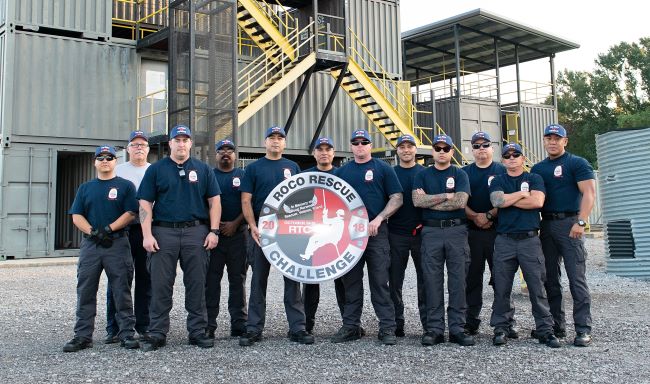 We recently received a great letter (below) from the Valero Rescue Team who participated in Roco Rescue Challenge 2018. The team is from Wilmington, CA, and is pictured here.
We recently received a great letter (below) from the Valero Rescue Team who participated in Roco Rescue Challenge 2018. The team is from Wilmington, CA, and is pictured here.
Thank you for having us at Rescue Challenge 2018. We had an amazing experience, as usual, and were exposed to a number of challenging scenarios. We were presented with many learning opportunities over the two days. Those learning opportunities never seem to end and are what makes attending Rescue Challenge so beneficial.
We get comfortable training at our facility over and over again, and your scenarios significantly put us outside of our comfort zone. I love it; and I speak for most of my team when I say they love it as well.
Every time we finish training or Challenge with the Roco guys, we take away stuff that makes us better rescuers...and that's all I've ever wanted to do since getting into the program four years ago.
Of course, my team and I were disappointed in our performance on the SAR on-air scenario. We are better than that, and we look forward to proving ourselves next year!
Our rescue team appreciates all of the hard work provided by you (Dennis), the staff and your families. Thank you for the experience and the opportunity to participate, compete, struggle, and learn.
Thank you,
Valero D-Shift Rescue Team


 Now that NFPA 1006 Standard for Technical Rescue Personnel Professional Qualifications (2017 edition) has been in place for a while, it’s a good time to revisit the changes that have been made. While we won’t go into every single change from the previous 2013 edition, we will cover some of the more significant ones – particularly for the specialty areas that we deal with most.
Now that NFPA 1006 Standard for Technical Rescue Personnel Professional Qualifications (2017 edition) has been in place for a while, it’s a good time to revisit the changes that have been made. While we won’t go into every single change from the previous 2013 edition, we will cover some of the more significant ones – particularly for the specialty areas that we deal with most.  On 6/30/17, at approximately 4:23 AM, the East Side Fire Department (ESFD) was contacted by the Denham Springs Fire Department (DSFD) to provide technical rescue assistance on the Amite River Bridge just outside the City of Baton Rouge. DSFD requested high angle rescue personnel to aid the fire personnel already on the scene in rescuing a person who had jumped from the Hwy. 190 bridge span. While in route to the incident, East Side personnel were advised that the person who jumped had fallen approximately 40 ft. and had succumb to his injuries. High angle rescue support was still needed to transport the deceased up to the roadway surface.
On 6/30/17, at approximately 4:23 AM, the East Side Fire Department (ESFD) was contacted by the Denham Springs Fire Department (DSFD) to provide technical rescue assistance on the Amite River Bridge just outside the City of Baton Rouge. DSFD requested high angle rescue personnel to aid the fire personnel already on the scene in rescuing a person who had jumped from the Hwy. 190 bridge span. While in route to the incident, East Side personnel were advised that the person who jumped had fallen approximately 40 ft. and had succumb to his injuries. High angle rescue support was still needed to transport the deceased up to the roadway surface.
 Roco would like to commend both the Denham Springs Fire Department and the East Side Fire Department for a safe and efficient recovery.
Roco would like to commend both the Denham Springs Fire Department and the East Side Fire Department for a safe and efficient recovery. House passes bill to toughen penalties for harming first responders
House passes bill to toughen penalties for harming first responders


